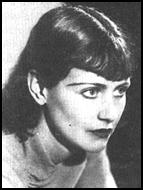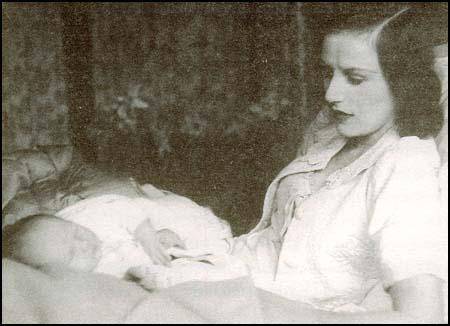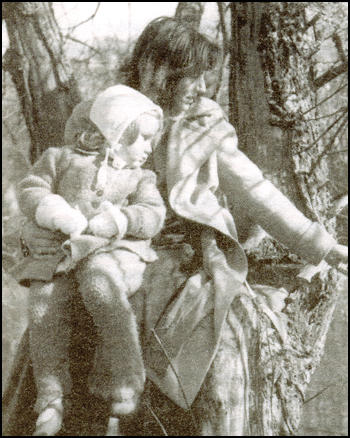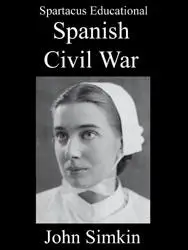Lorna Garman Wishart

Lorna Garman was born on 11th January 1911 at King's Pyon, Herefordshire, the youngest child of Walter Garman, the medical officer for Wednesbury, and Margaret Magill, who was nearly twenty years younger than her husband. Margaret had eight other children: Mary (1898), Sylvia (1899), Kathleen (1901), Douglas (1903), Rosalind (1904), Helen (1906), Mavin (1907) and Ruth (1909). The family lived at Oakeswell Hall, Wednesbury.
Her father died in May 1923 after suffering a heart-attack. Cressida Connolly, the author of The Rare and the Beautiful: The Lives of the Garmans (2004), claims: "Only twelve years old at the time, she was told of her father's death while she was away at boarding school. As soon as she heard the news she jumped over the tennis net for joy, knowing this meant that she would be able to leave the hated school and begin a new life of freedom." Anne Pimlott Baker has argued that "released from boarding-school on the death of her father, she led a carefree teenage life, roaring about on the back of boys' motorbikes".
At university her brother Douglas Garman became friends with Ernest Wishart, the heir of Sir Sidney Wishart, a successful insurance broker and the sheriff of the City of London. In the summer of 1925 Douglas took Wishart to meet his family. This included Lorna, his fourteen-year-old sister, According to Cressida Connolly: "Ahead of her years, and wild, she seduced the much older Wishart in a hayrick."
Lorna married Wishart at the age of sixteen and went to live in the family house at Marsh Farm, Binsted. Her first son, Michael, was born a year later. By the age of twenty-one she had given birth to a second son, Luke. She spent much of her time in London. Michael later remembered how she was often "dressed for dancing in clinging sequins" when she said goodnight to him. He described her as resembling "a sophisticated mermaid".
Lorna was considered the most beautiful of all the Garman sisters. A friend, Pauline Tennant, later commented: "The great thing about Lorna is that she had these amazing eyes. They were profoundly blue. When she looked at you, you felt transfixed. She was remarkably beautiful." Peggy Guggenheim agreed: "Lorna was the most beautiful creature I had ever seen. She had enormous blue eyes, long lashes and auburn hair." One of her nieces said that "Lorna was just glamorous, like a Hollywood star."

Lorna was extremely promiscuous. Her most important lover was the writer, Llewelyn Powys, who was twenty-seven years her senior. Powys wrote after their first meeting: "I shall never forget that laugh - so free, so lovely, so scandalous that rang so gaily through our home." Cressida Connolly wrote: "She saw very little of Llewelyn, and their lovemaking was of necessity seized in the brief intervals when they could be alone. She was still hungry for experience, for love, for more."
Ernest Wishart merged his company with the publishing house of Martin Lawrence in 1935. Moving to Red Lion Square, Lawrence and Wishart became the press of the Communist Party of Great Britain. The company concentrated on publishing books on economics, working-class history and the classics of Marxism. Wishart also published New Writing, a twice-yearly anthology, that included the work of W.H.Auden, Ralph Fox, Christopher Isherwood and Cecil Day Lewis.
In 1937 Lorna was out walking alone on the beach at Gunwalloe when she saw a young man playing a violin. She stopped and asked him to play for her. The man was Laurie Lee, then aged twenty-three: Valerie Grove has argued: "Rich, startlingly beautiful, the mother of two sons, she tempted and taunted him, showered him with gifts, was his Muse."
Lee was a strong supporter of the Republicans in Spain and later that year he decided to join the International Brigades. In his autobiography, A Moment of War, he explained what happened: "I told her my plans one evening as she sat twisting her hair with her fingers and gazing into my eves with her long cat look. She wasn't impressed. Others may need a war, she said; but you don't, you've got one here. She bared her beautiful small teeth and unsheathed her claws. Heroics like mine didn't mean a thing. If I wished to command her admiration by sacrificing myself to a cause she herself was ready to provide one."
Lorna's brother, Douglas Garman, also wanted to join the International Brigade. However, as Peggy Guggenheim explained in her autobiography, Out of the Century (1979): "It was during the period of the Spanish War and he was very excited about it. I was afraid he was going to join the International Brigade, but his health would not permit." Kathleen's boyfriend, Jacob Epstein, also attempted to go but he was denied a visa.
On 5th December 1937 Laurie Lee crossed the Pyrenees and arrived at Albacete ten days later. He was then sent to the training centre at Tarazona. A report written at the end of the month concluded: "It seems clear that being, generally speaking, physically weak, he will not be of any use at the front. He agrees that the added excitement would be too much for him. On the other hand he seems a perfectly sincere comrade, who is very sympathetic to the Spanish government." Lee later commented: "I trained as a soldier, but I was mainly used in the International Brigade headquarters in Madrid during the siege, making short-wave broadcasts to Britain and America".
Laurie Lee left Spain on on 19th February, 1938. On his return to London he went to live with Lorna in Bloomsbury. According to Lee she was "rich and demandingly beautiful, extravagantly generous with her emotions but fanatically jealous". Their daughter, Yasmin, was born in February, 1939. However, three months later she decided to return to her husband. Ernest Wishart had made it a condition of taking her back that she stop seeing her lover.
However, the relationship continued. Valerie Grove has pointed out: "During the war he camped in a caravan near her husband’s Sussex estate; she arrived daily in her Bentley, bringing poetic inspiration and erotic fulfilment." Lee wrote at the time, "I cannot think why lovers ever leave their beds." Lee eventually left the caravan near Cissbury Ring and took a cottage in Bognor Regis. Lorna was intensely jealous of Lee. She wrote at the time: "I'm longing for you to grow old, each new wrinkle on your face is a joy to me - I want you to grow old and repulsive so that no one will want to look at you."

As John Cunningham pointed out: "Ernest Wishart was extremely forgiving. He seems to have accepted Lorna's bohemian streak, which ranged from her erotic encounters in an old farm-bound caravan that Lee rented in Sussex, to getting drunk with the literary set in London during the blackout. It might have been no more than damage limitation to keep the children of two fathers together, but, in agreeing to it, Wishart seems nobler than Lee, who didn't acknowledge his daughter until, as an adult, she sought him out."
In 1942 Lorna and Ernest Wishart met the young artist, Lucian Freud, on holiday at Southwold. Lorna was ten years older than Freud but they soon became lovers. Freud's friend, John Craxton, commented: "Lorna was the most wonderful company, frightfully amusing and ravishingly good-looking: she could turn you to stone with a look. And she had deep qualities; she was not fluttery, she wasn't facile at all. She had a kind of mystery, a mystical inner quality. Any young man would have wanted her."
Lorna continued to see Laurie Lee. She wrote to Stephen Spender and Cyril Connolly about his talent and as a result some of his poems were published in Horizon. Lee's first volume of poetry, The Sun My Monument was published in 1944. Lorna also persuaded Connolly, the editor of the magazine, to use some of Freud's drawings.
According to her daughter Yasmin: "Lorna was a dream to any creative artist because she got them going. She was a natural muse, an inspiration. She was a symbol of their imagination, of their unconscious, she was nature herself: savage, wild, romantic and without guilt.'' Yasmin added: "She was amoral, really, but everyone forgave her because she was such a life-giver."
Lucian Freud used her as the model for Girl with Daffodil and Woman with a Tulip. However, in 1945, Lorna discovered that Freud had started a relationship with a young actress. She now broke off the affair and returned to Ernest Wishart. According to Cressida Connolly: "Freud was deeply unhappy and pursued her to Sussex, where he went to stay with Peter Watson. On one occasion he arrived at Binsted with a gun, saving he would shoot Lorna, or himself, there and then if she would not come back to him. He stood in the cabbage patch and fired the gun, but no one was hurt."
Following her conversion to Roman Catholicism she destroyed all her letters from her lovers and devoted herself to supporting her husband at their house at Marsh Farm, Binsted. Kathleen's daughter, Kitty said: "She became very, very Catholic and gave away all her jewellery and went to mass every day and renounced all her lovers." As John Cunningham has pointed out: "She became a Roman Catholic, lived in the South Downs - and contrived to keep her secrets. She burned letters from her two famous lovers, saying it was nobody's business but hers. Every inch a mistress to the last." However, she did keep a photograph of Llewelyn Powys, who had died in 1939.
The author of The Rare and the Beautiful: The Lives of the Garmans (2004), has argued: "She (Lorna) and her husband quarrelled over Catholicism and socialism, although he relinquished his faith in Marxism after the Hungarian uprising of 1956 and she became less fervent with age." Ernest Wishart died after a long illness, on 16th September 1987. Cressida Connolly has pointed out that "to everyone's surprise, she became a devoted and efficient nurse to her husband during his final illness."
Lorna's son, Michael Wishart, died from cancer in 1996. Not long after she was involved in a serious car accident, from which she never fully recovered.
Lorna Garman Wishart died of bronchopneumonia and cerebral arteriosclerosis at Walberton Place Nursing Home on 12th January 2000.
Primary Sources
(1) Laurie Lee, A Moment of War (1991)
I told her my plans one evening as she sat twisting her hair with her fingers and gazing into my eves with her long cat look. She wasn't impressed. Others may need a war, she said; but you don't, you've got one here. She bared her beautiful small teeth and unsheathed her claws. Heroics like mine didn't mean a thing. If I wished to command her admiration by sacrificing myself to a cause she herself was ready to provide one.
(2) Peggy Guggenheim, Out of the Century (1979)
Garman drove me to Sussex to show me the house he had bought for his mother. It was in a little English village called South Harting, just under the downs. The village was absolutely dead, like all such places in England, but it was in the midst of the most lovely country. Naturally, it had a fine pub. Garman also took me to see his sister Lorna and his brother-in-law, the publisher Ernest Wishart, whom he called Wish. They had a lovely home. Garman and Wish seemed to be the verv best of friends, having been to Cambridge together. Wish's wife Lorna was the most beautiful creature I had ever seen. She had enormous blue eyes, long lashes and auburn hair. She was very young, still in her early twenties, having been married at the age of sixteen. Out of seven sisters, she was Garman's favorite.
(3) Cressida Connolly, The Rare and the Beautiful: The Lives of the Garmans (2004)
She (Lorna) loved to swim, and would do so anywhere, at any time of year and long into her old age. She'd strip to her knickers and plunge into thirty-foot waves in Cornwall in the winter, or into remote lakes or fast-flowing icy rivers. She'd swim naked in the shallow, weedy water by Arundel, mocking anyone too prim to take off their things and join her. She was feckless in her generosity, giving away money or jewellery on a whim. She never felt guilty, never felt ashamed. "She was amoral, really," says her daughter, "but everyone forgave her because she was such a life-giver." Being unconventional was almost a point of honour. She drank Guinness at the hairdresser's. She hated crowds. She loved cricket. She was romantic and passionate, but she also had a flinty streak, a heartlessness. She was not without vanity, and she could be cruel, yet she was also capable of great kindness.
Because Wishart had married her when she was only sixteen, he seemed to accept that she would have love affairs. But their marriage was no sham. They were devoted to one another. Every day they took long walks together in their ancient Sussex woodland, talking for hours. In later years, when Lorna had converted to Roman Catholicism (a decision influenced by her sister Mary's ardent faith), they would argue terribly, Wishart for socialism, Lorna for religion.
(4) John Cunningham, The Guardian (21st January, 2000)
Two generations ago, Lorna Wishart discovered that being the lover of a poet was even more draining than mothering a family and running the house for her well-connected husband. On a family holiday in Cornwall in 1937, she saw a young lad with a violin strolling by. "Boy, come and play for me," she called out. The fiddler was Laurie Lee and, once they became entangled, he apparently called the tune at least as often as she, in spite of the difference in their social status. The lad from Slad Valley in Gloucestershire had a penny-pinched childhood and an absent father; she was one of seven daughters of a well-off doctor, Walter Garman, who married Ernest Wishart when she was only 16.
Alongside tales of his bucolic boyhood in Gloucestershire and his exploits in the Spanish civil war, Lee's relationships with women fuelled his volumes of autobiography and poetry until his death in 1998. But, beautiful and vivacious though she was, Lorna had far more than sex to offer Lee.
As well as being the inspiration for many of his compositions, she ensured that his early poems saw the light of day by commending them to Stephen Spender and Cyril Connolly at Horizon, which was the literary magazine to appear in. When he decided to join the struggle in Spain, she is said to have sent him pound notes dabbed with Chanel No 5; it's also said that she got friends to bring him out of the country when he was in danger.
All of this demanded flexibility and deceit, since she remained married to Wishart, and brought up their children. Also, her affair with Lee was conducted during the 1939-45 war.
When Lorna became pregnant by Lee, she handled it with stunning competence. Their daughter, Yasmin, was born in February, 1939. Lorna was on one of her temporary absences from her family, and the couple were living in a flat in Bloomsbury. A good mistress can do even more for a literary man than a top agent: the baby was brought up along with the Wishart children.
Ernest Wishart was extremely forgiving. He seems to have accepted Lorna's bohemian streak, which ranged from her erotic encounters in an old farm-bound caravan that Lee rented in Sussex, to getting drunk with the literary set in London during the blackout. It might have been no more than damage limitation to keep the children of two fathers together, but, in agreeing to it, Wishart seems nobler than Lee, who didn't acknowledge his daughter until, as an adult, she sought him out.
The literary recognition Lorna received from the poet was limited to having The Sun My Monument - a book she inspired - dedicated to her. In the official biography, Laurie Lee: The Well-Loved Stranger, author Valerie Grove remarks that while the poet often said he loved women, "he never paid tribute to them as mentors; only as cosseting, embracing, accommodating creatures. He liked women, but in their place.''
Lorna's genius as a mistress was that she recognised this, and knew when to move on - as she did, to Lee's torment, when she encountered Lucian Freud as a 21-year-old painter. And on from him - after she had become Girl with Daffodil in one of his portraits.
The effect she had on her two lovers seems to have been that of a catalyst. Yasmin is quoted in Grove's book as saying of her mother: "Lorna was a dream to any creative artist because she got them going. She was a natural muse, an inspiration. She was a symbol of their imagination, of their unconscious, she was nature herself: savage, wild, romantic and without guilt.''
Others in Lorna's family were less than conventional. Two of the seven Garman sisters ran away to London in 1920: Mary fell for and married the South African poet Roy Campbell, while Kathleen shacked up with the sculptor Jacob Epstein, having three children before he was free to wed.
When Lorna came to marry at 16 it was fortuitous that her husband was wealthy - and unconventional. He was a communist, who set up the publishing firm Lawrence and Wishart. And, after her career as a literary mistress, it was to life with Wishart that Lorna returned. She became a Roman Catholic, lived in the South Downs - and contrived to keep her secrets. She burned letters from her two famous lovers, saying it was nobody's business but hers. Every inch a mistress to the last.
(5) Valerie Grove, The Times (9th June, 2004)
Lee was captivated, in the 1930s, by a woman named Lorna Wishart. Rich, startlingly beautiful, the mother of two sons, she tempted and taunted him, showered him with gifts, was his Muse, bore him a daughter. During the war he camped in a caravan near her husband’s Sussex estate; she arrived daily in her Bentley, bringing poetic inspiration and erotic fulfilment. And then, in 1943, she broke his heart. She had become infatuated with a 20-year-old Berlin-born artist, a boy wonder of the art world, with dark hair and pale, mesmeric eyes - Lucian Freud. She became his Muse, too: she was his first portrait subject, the first woman who meant anything to him. And when Wishart ditched him, he married Kitty, one of Wishart’s nieces, as his first wife - portrayed in his Girl With A White Dog, in Tate Britain. (Two years later, Lee did the same: he married Kathy, another of Wishart’s nieces.) This enthralling tale of a true femme fatale will be told later this summer in The Rare and the Beautiful, Cressida Connolly’s composite biography of Wishart and her eight equally amazing siblings.

